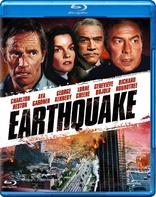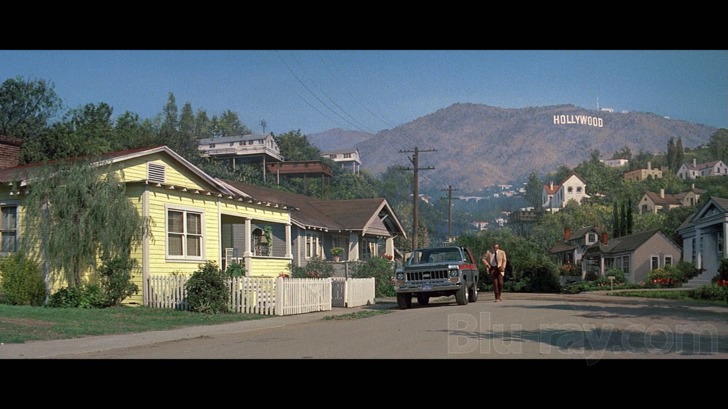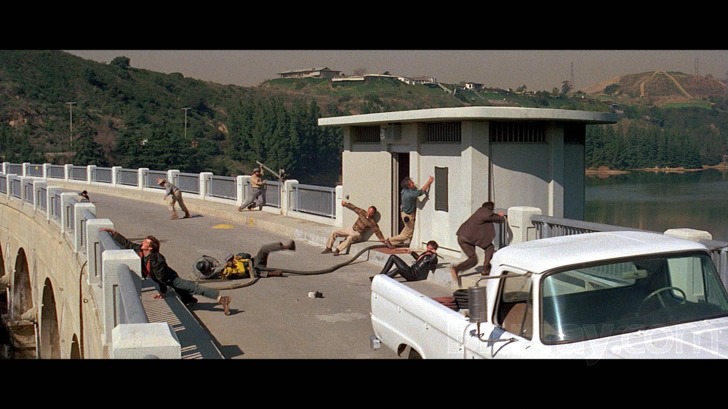Earthquake Blu-ray Movie
HomeEarthquake Blu-ray Movie 
Universal Studios | 1974 | 122 min | Rated PG | Jun 04, 2013
Movie rating
6.5 | / 10 |
Blu-ray rating
| Users | 3.7 | |
| Reviewer | 3.5 | |
| Overall | 3.5 |
Overview
Earthquake (1974)
Various interconnected people struggle to survive when a massive earthquake rips Los Angeles apart. Released in SENSURROUND.
Starring: Charlton Heston, Ava Gardner (I), George Kennedy, Lorne Greene, Genevičve BujoldDirector: Mark Robson (I)
| Thriller | Uncertain |
| Drama | Uncertain |
| Action | Uncertain |
Specifications
Video
Video codec: VC-1
Video resolution: 1080p
Aspect ratio: 2.35:1
Original aspect ratio: 2.39:1
Audio
English: DTS-HD Master Audio 5.1 (48kHz, 24-bit)
English: DTS Mono .1 Sensurround
French: DTS 5.1 (48kHz, 24-bit)
English DTS 5.1 designated as "2.1 with Sensurround"
Subtitles
English SDH, Spanish
Discs
50GB Blu-ray Disc
Single disc (1 BD)
Playback
Region free
Review
Rating summary
| Movie | 3.5 | |
| Video | 3.0 | |
| Audio | 3.5 | |
| Extras | 0.0 | |
| Overall | 3.5 |
Earthquake Blu-ray Movie Review
Faulty Towers
Reviewed by Michael Reuben June 7, 2013Released in the same year as The Towering Inferno, Universal's Earthquake is a continuation of the wave of disaster films that the studio launched in 1970 with Airport. Fox hopped on the trend with The Poseidon Adventure in 1972, then took the unusual step of partnering with Warner to produce the hugely expensive Inferno. Not to be beaten at its own game, Universal developed Earthquake, which would have the advantage—and pose the technical challenge—of depicting catastrophe on a much larger canvas than a single airplane, ship or skyscraper. For its time, Earthquake was a technical marvel, combining miniatures, matte paintings and huge practical sets constructed on the Universal backlot. Legions of stunt people were recruited for key sequences of choreographed mass havoc. The entire production was entrusted to the hand of veteran director Mark Robson, whose career in Hollywood dated back to his work as an assistant editor on Citizen Kane. Robson's experience helming sudsy creations such as Peyton Place and Valley of the Dolls proved useful when it came to the "dramatic" portions of the film—and I put "dramatic" in quotes, because the drama in a classic disaster film is always subservient to the effects. It's conveyed in shorthand, consuming as little screen time as possible. To write Earthquake's script, Universal secured the bragging rights of signing Mario Puzo, red hot from the success of The Godfather. But Puzo was already committed to Paramount for The Godfather, Part II, and he left after finishing a first draft. Writer George Fox was hired to work with Robson on winnowing Puzo's detailed draft into something that would fit within Universal's budget. Even so, the final product featured the large cast typical of the genre and the broad scale that Universal wanted for its second disaster feature.

It's a beautiful day in Los Angeles, and the Hollywood sign gazes down upon the citizenry with its customary benevolence. Of course, since the title of the film is Earthquake, we know that won't last. I generally wouldn't review a film by listing the players, but that's pretty much how disaster films are constructed—and Earthquake more than most. The dialogue telegraphs character and relationships with maximum compression, and the only reason it doesn't fall with a resounding thud (an assessment not every viewer would share) is that the cast is classy enough to elevate the material. All of them understand that they're just there to prepare for the Big One that's coming. In rapid succession, we meet:
- Stewart Graff (Charlton Heston), a construction engineer, former football player and fitness fanatic, who believes in building structures to withstand earthquakes even if it means exceeding the building code specs and spending more than you have to.
- Remy Graff (Ava Gardner), Stewart's jealous and unhappy wife, who believes her husband is having an affair and is perfectly willing to fake a suicide attempt to get his attention.
- Sam Royce (Lorne Greene), the head of Stewart's construction firm and Remy's father, a solid but practical businessman who respects Stewart and just wants his daughter to be happy. (If you find it difficult to accept Greene as the father of Ava Gardner, it's because he was not quite eight years her senior.)
- Denise Marshall (Genevičve Bujold), the widow of one of Stewart's former co-workers, who was killed in an industrial accident. She is newly returned to town with her young son, Corry (Tiger Williams), where she is seeking work as an actress. Stewart has been unusually attentive. In fact, they are about to begin an affair, just as Remy suspects.
- Barbara (Monica Lewis), Sam Royce's secretary and Denise Marshall's friend.
- Lew Slade (George Kennedy), an L.A. cop with a temper and a passion for justice, who gets suspended that day after causing major property damage in Beverly Hills in pursuit of a hit-and-run driver and punching out a sheriff's deputy who tries to stop him. Lew drowns his sorrows in a neighborhood bar.
- Emilio Chavez (Pedro Armendáriz Jr.), Lew Slade's sympathetic partner.
- The Drunk (Walter Matthau, jokingly credited as "Walter Matuschanskayasky"), a soused regular at the bar where Slade goes after being suspended. He shows up periodically toasting random names.
- Jody Joad (Marjoe Gortner), the mild-mannered manager of a local grocery store, who undergoes a complete transformation when his reserve status in the National Guard is activated in response to the earthquake emergency. The chance to play soldier unleashes every dark impulse Jody has suppressed in civilian life, and he becomes a danger to everyone, especially . . .
- Rosa Amici (Victoria Principal), a pretty young thing who shops at Jody's store and is perpetually short of cash, mostly because she's constantly being hit up for loans by her brother and his crazy partner (see below).
- Sal Amici (Gabriel Dell), Rosa's brother, who manages the act of his good friend . . .
- Miles Quade (Richard Roundtree), a flamboyant motorcycle daredevil, whose stunts involve jumping through rings of fire and other death-defying feats. In his own mind, Quade is far more impressive than Evil Kneivel.
- Walter Russell (Kip Niven), a precocious junior staff member at the California Seismological Institute, who accurately predicts the big quake by extrapolating from work developed by his immediate superior, who is out in the field (and never returns).
- Dr. Willis Stockle (Barry Sullivan), the head of the Seismological Institute, who is initially reluctant to accept Russell's forecast, but agrees to alert the city's mayor (John Randolph) when an early tremor that Russell predicted occurs on schedule.
- Assistant Caretaker at the Hollywood Dam (Scott Hylands), a character who doesn't rate a name but plays a crucial role in the story. As a result of a fatality early in the day, the dam is subject to intensive testing and inspection, even before the earthquake hits. The assistant caretaker, who knows every inch of the place, keeps insisting that something is seriously amiss, because he sees too many changes happening, but his concerns are dismissed, because, after all, he's just a caretaker. He will, of course, prove to be right.
Earthquake Blu-ray Movie, Video Quality 

Cinematographer Philip H. Lathrop was nominated for an Oscar for his beautiful widescreen imagery of Earthquake, a demanding task that required him to harmonize minitatures, opticals and full-scale practical effects into a convincing whole. Universal's 1080p, VC-1/encoded Blu-ray presentation of Lathrop's work is certainly watchable and, in some circles, might even be considered superior—that is, unless you are one of those finicky viewers who happens to like the look of film. Let's start with the positives. The image is generally sharp and detailed, remarkably so for the anamorphic lenses and film stocks of this particular era. (Hold that thought for a moment.) The blacks are solid and deep, which is essential for the night scenes and the extended sequences in tunnels and underground. The colors are vivid, varied and well-saturated, which is crucial to the look of Southern California and the frequently hilarious Seventies fashions. My viewing companion remarked on the darkness of many of the fleshtones, but in this era in California, dark tans were the norm. People worried far less about sun damage than they do today. Some of the characters (e.g., Genevičve Bujold's Denise) are meant to be fair-skinned, and they look the part. Now let's talk about that sharpness. It isn't the natural look of the original cinematography. Rather, it's an electronically induced sharpness of the subtle kind that doesn't create edge halos but does distort the film's grain pattern so that it no longer moves in a smooth and natural fashion. Instead, we get what I call (and this is not a technical term) a "dirty" image, that is, an image with a thin layer of video noise that is most easily observed in light-colored expanses such as the sky. At its most extreme, this phenomenon causes portions of the frame to shimmer in a manner similar to aliasing, but fortunately these occasions are rare. In general, though, the entire Blu-ray looks as if someone had turned up the sharpness control on your TV set. On screencaps, the noise may not be readily evident; it is sometimes even mistaken for grain. In motion, it is unmistakable. It's unfortunate that Universal seems to be continuing their efforts to make film look like video, because they're doing everything else right. They've put Earthquake on a BD-50, allowed it a generous average bitrate of 31.61 Mbps and avoided any compression artifacts. The "dirty" video noise isn't a dealbreaker, but why add it in the first place?
Earthquake Blu-ray Movie, Audio Quality 

Earthquake was the first of four films released theatrically in "Sensurround", a short-lived venture between Universal and speaker manufacturer Cerwin-Vega that attempted to enhance the theatrical experience by adding low frequency effects that were intended to be felt more than heard. The format was abandoned for a variety of reasons, including the cost to theater owners and the tendency for the Sensurround vibrations to damage ceilings, especially in older structures, and cause fragments of plaster to fall on patrons' heads. Earthquake comes with two English-language tracks. One is a lossless DTS-HD MA 5.1, which is presumably based on the 6-track mix created for the 70mm release. The other is labeled as "DTS 2.1 with Sensurround". I switched back and forth between them while watching the film and ultimately preferred the 2.1 track, because the 5.1 track has the dialogue mixed too low. I never experienced Sensurround in a properly equipped theater, but those who did have been disappointed with the home theater equivalent, which uses the system's low-frequency "control tones" to indicate a deep bass presence but doesn't vibrate the environment as the original system was intended to do. (For that, one would have to install additional equipment, such as a tactile transducer or a d-Box system.) In any case, the bass extension on Earthquake's soundtrack is certainly impressive for a film of this vintage and will make good use of whatever subwoofer you have in your system to intensify the film's major disaster sequences. As I noted in my review of Battlestar Galactica, contemporary viewers are used to such things, so that they are no longer a novelty. Sonically, though, these sequences are still effective. For the rest, the dialogue is clear, and John Williams' score strikes an effective note of urgency. The sounds of chaos are just as effective coming from the front speakers as they would be if they were spread all around.
Earthquake Blu-ray Movie, Special Features and Extras 

The disc has no extras.
Earthquake Blu-ray Movie, Overall Score and Recommendation 

Disaster films wore out their welcome after a few years, and Airplane! 's parody signaled the end of their run. But they made a comeback in the Nineties with the twin volcano films, Dante's Peak and Volcano, and then the twin meteor films, Deep Impact and Armageddon. Still, once computer graphics took over, nothing was ever the same. As cheesy as some of their effects look now, there was something ineffably authentic about the original crop from the Seventies that later entries have yet to capture. So, in spite of less than perfect video, recommended.
Other editions
Earthquake: Other Editions

Earthquake
1974

Earthquake
Collector's Edition
1974

Earthquake 4K
1974

Earthquake 4K Limited Edition SteelBook
1974
Similar titles
Similar titles you might also like

Airport 1975 4K
1974

The Concorde... Airport '79 4K
1979

Airport '77 4K
1977

Snakes on a Plane
2006

Count Yorga, Vampire
1970

Assault on Precinct 13
Collector's Edition
1976

Rollercoaster
1977

The Stone Killer
Limited Edition to 3000
1973

'Gator Bait 4K
1973

Airport 4K
1970

Death Wish 4K
1974

13 Minutes
2021

Death Wish II 4K
Slipcover in Original Pressing
1982

Devil Times Five 4K
Peopletoys / Slipcover in Original Pressing
1974

Sharknado 2: The Second One
2014

The Bees
1978

Dogs
1976

Sharknado
2013

Death Machines
Death Machine
1976

Deadly Prey
1987